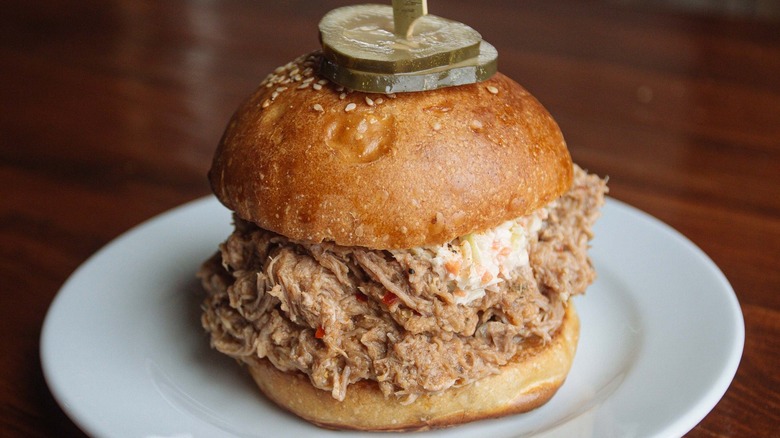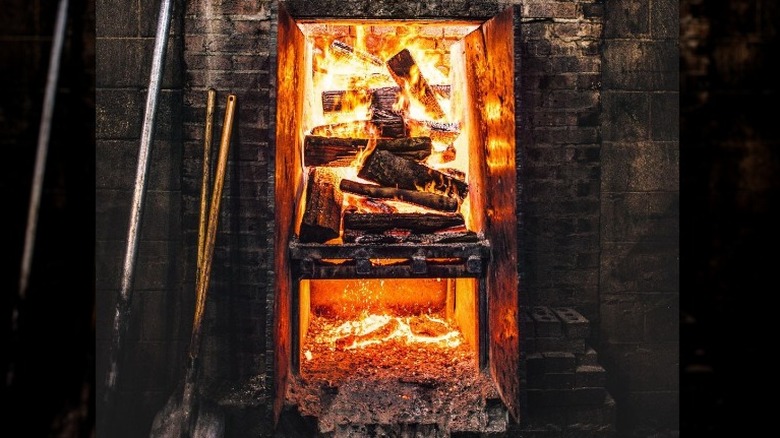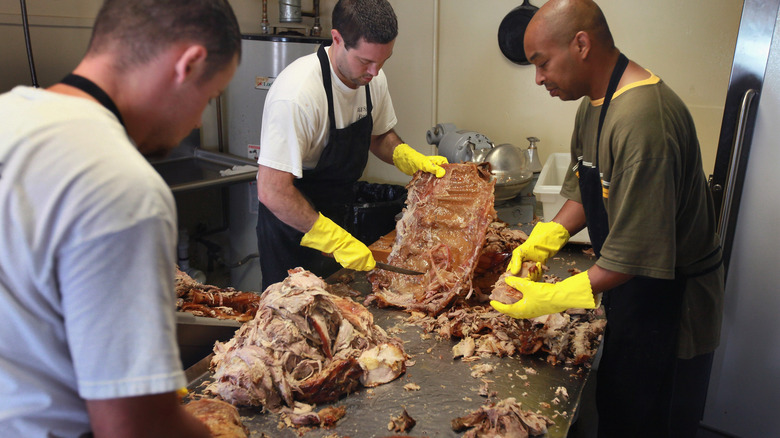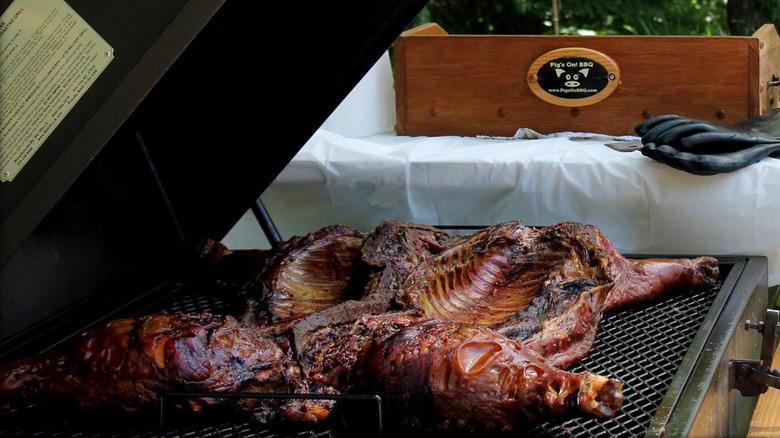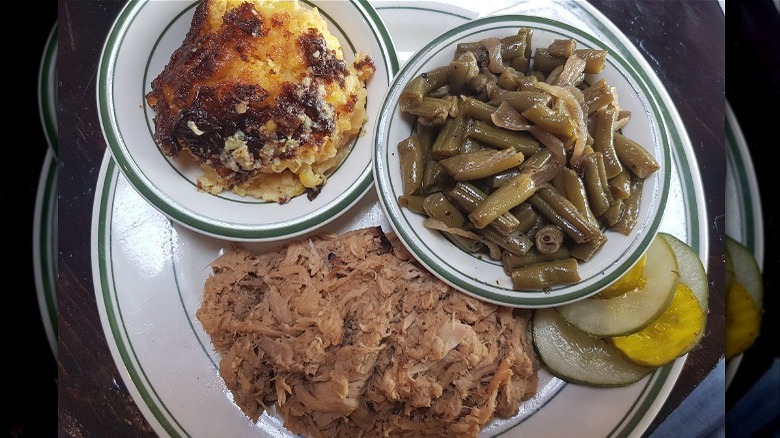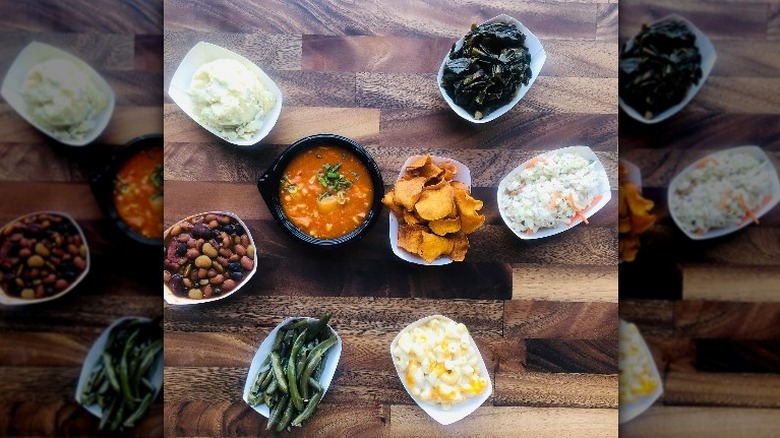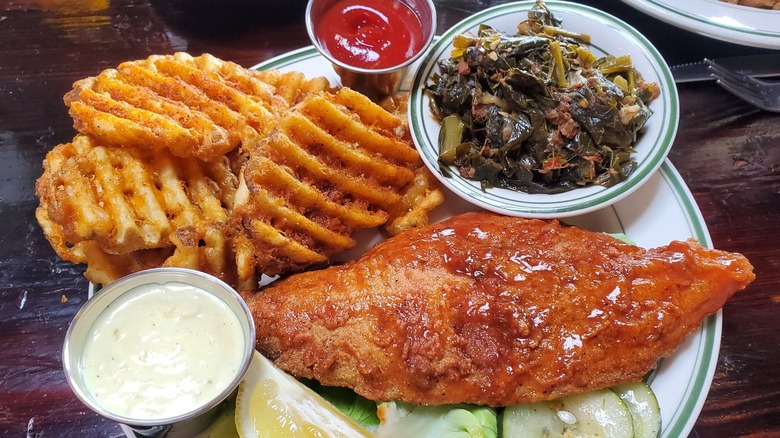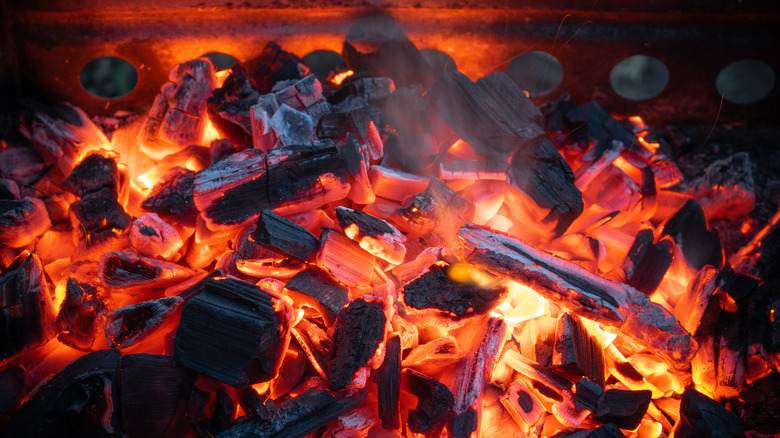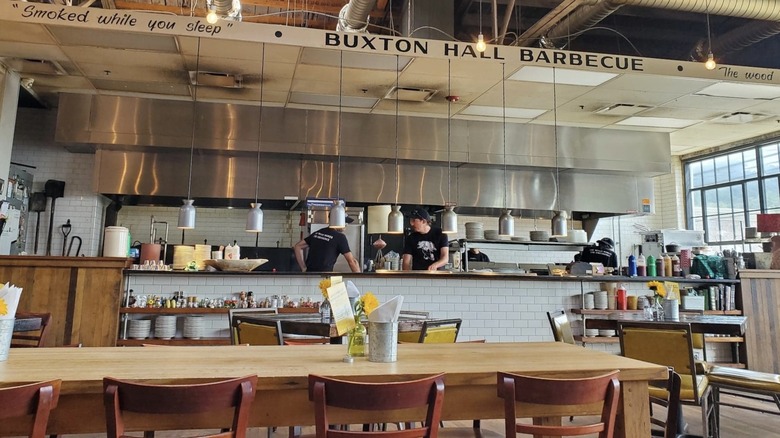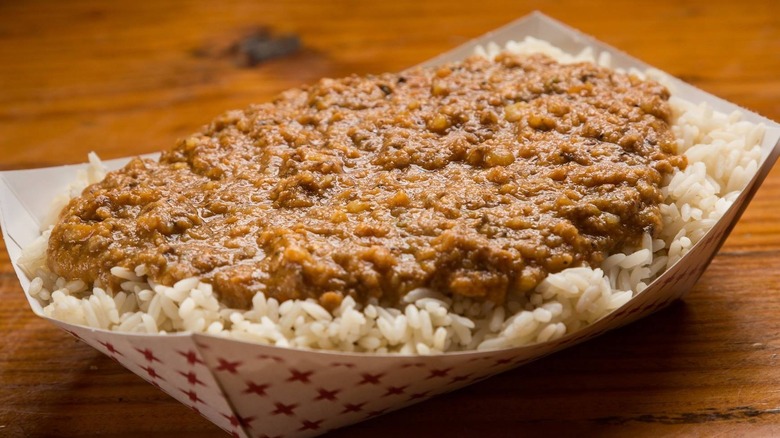Everything You Need To Know About North Carolina Barbecue
The United States' love affair with barbecue is well-documented and exemplified from coast to coast. No matter where you are in the country, you're not far from a loaded plate of barbecued meat. That being said, the elements that make up a meal vary from place to place, as do the cooking methods and overall flavor profile. While there's no use in trying to label one style as better than any other, honing in on the regional nuances provides a broader understanding of barbecue cuisine as a whole.
North Carolina boasts an interesting geographical location, with both coastal and mountainous regions. With such diversity, the state's culinary outlook is vast and rooted in local products and traditions. Barbecue undoubtedly comes out among the more influential types of food in North Carolina, and, in fact, the state is likely the home of American barbecue (via The Washington Post).
With distinctions from east to west, smoking and cooking meat over a wood fire are favorite pastimes among many local cooks. Discover the ins and outs of barbecue in this southeastern part of the country — it might prove to become a new favorite.
The origins of North Carolina barbecue
Barbecue evolved across the country as a necessity to feed many people while dealing with a lack of refrigeration. In North Carolina, the tradition has always been ingrained in the community. From the time Spanish settlers brought pigs to the region in the 1500s, the animals quickly became an important source of protein in local recipes (via Whole Hog Barbecue). Cooking the entire pig was common practice in the eastern part of the state, which by default meant many people could be fed.
According to Jim Early's book "The Best Tar Heel Barbecue," an English explorer tasted wood-fired slow-cooked pork made by natives on Roanoke Island off the coast, and immediately fell under the spell of barbecue, says Charlotte Magazine. Similarly, other early explorers happened upon the local Croatan Native Americans cooking fish over fire, and followed up by testing the method themselves, as the author of "Holy Smoke: The Big Book of North Carolina Barbecue" John Shelton Reed explains, notes Charlotte Mecklenburg Library.
Reed notes that barbecue naturally became an essential component of celebrations and special occasions in the 1800s, adds Elon News Network. What was first a staple at community-organized events took on a more commercial focus as wood-fired meat began being sold at stalls and events. The first official stand opened for business in Lexington in 1919, cementing the city as the source of the popular cuisine, reports NCpedia. Ultimately, this became the foundation for hundreds of restaurants across the state.
The pig is the focus
Although new recipes are in constant experimentation at restaurants across the state, there's no way around it — pork is the star of the show. Traditionally, the whole hog has been the preferred method of preparation. Given the limited capacities of refrigeration in the past, killing an animal meant it had to be cooked in its entirety in order to feed many people without letting food go to waste, adds Southern Kitchen. Nowadays, a distinction determines whether you're looking at eastern or western (Lexington) style barbecue; the former cooks the entire animal while the latter tends to prioritize the pork shoulder (via Whole Hog Barbecue).
Whether the pig is cooked as a whole or in parts is also a matter that varies among restaurants. At Buxton Hall in Asheville, General Manager Brandon Grogan explained to us that chefs had to reexamine their smoking technique several times to avoid setting the place on fire yet another time. Although the restaurant still cooks the complete animal, cooks break it down into parts before loading it up into the smoker to avoid any other flaming disasters. And if you're wondering how many pigs are consumed at this busy restaurant on a weekly basis, culinary director Nick Barr counts around six.
Eastern vs. Western style barbecue
It would be too simple for the entire state of North Carolina to agree upon the standards for barbecue, and indeed a divide can be made west of Highway 1, according to The Lexington Collection. Starting with the meat itself, Eastern tradition calls for the whole pig to be cooked, whereas the Western (aka Lexington or Piedmont) style focuses on the pork shoulder. As the Southern Kitchen reports, the latter method was favored by German immigrants to the region.
Moving on to the flavor profile, a thin vinegar and pepper sauce is fundamental in the east, whereas western preparations tend to contain an added tomato or ketchup component, another influence of the Germans, according to the book "Holy Smoke" (via NCpedia). The sauce is typically served on the side as well, serving as a dip for the pork. As Katie Quine writes in Our State, attempting to convince anyone firmly rooted on either side of the Highway 1 debate that the alternative type of barbecue is better is a surefire way to anger diehard fans.
Meanwhile, side dishes tend to be regionally favored, and while standard creamy coleslaw, collards, cornbread, and boiled potatoes are staples of Eastern barbecue plates, in the west you're looking at options like tangy red coleslaw, hushpuppies, and fries, says Cook's Country.
Signature dishes on the table
It's no secret that pork reigns as the true king of North Carolina barbecue. In fact, according to a report by NC State University, in 2019 the industry was responsible for $10 billion in sales (via NC Pork). Whether it's served as a sandwich in a simple bun with coleslaw, or loaded onto a plate with assorted sides, pork is the star of traditional styles. Depending on the region and establishment, your options typically include sliced, pulled, or chopped pork.
The meat itself is slow-cooked over oak and/or hickory smoke and basted in a vinegar pepper sauce or dry rub to infuse flavor. It's undoubtedly a low and slow cooking process, and hogs are often smoked for 12 hours. This means that restaurants doing it the traditional way need to be staffed with a nighttime pitmaster.
Using wood instead of gas or electricity and requiring extra overnight staff to man the smoker means that places looking to save a quick buck are skipping out on traditions, says The Washington Post. The smell of burning wood as you walk into an establishment is a clear sign that the meat is being properly smoked. Ultimately, there's no way around it: Wood-fired simply tastes superior.
Accompanying side dishes
Barbecue plates and sandwiches are served with assorted side dishes, including standards like coleslaw (creamy in the east, red and tangy in the west), boiled potatoes, hush puppies, and collard greens. Regional distinctions are common; Brunswick stew, a rich preparation of potatoes, meat, vegetables, beans, and salted pork, would be missed in some areas, whereas other places stick to corn pudding, cornbread, mac and cheese, and fried potatoes (or waffle fries — a must-try side at Buxton Hall). Meanwhile, popular Southern dishes like pimento cheese and deviled eggs might grace your plate.
Once again, sides are an obvious source of experimentation at restaurants open to novelty. If you're worried about a lack of options, Angela Koh from 12 Bones comments, "We have 10 to 12 sides on at any given time and there are definitely some crowd favorites." She adds, "The damn good corn puddin', collard greens, jalapeño cheese grits, and our smoked potato salad are always at the top of the list." And if you're thirsty — which you will be — a good old Southern sweet iced tea is a classic option. Or else, Koh asks, "What goes with bbq better than a cold glass of beer?"
Experimental styles
Asheville's dining scene is steadily evolving, earning the title as the U.S.'s top food destination in 2022, adds Travel + Leisure. Local barbecue restaurants are harnessing the interest and serving dishes fit for a foodie's dream. While the menus might seem far from North Carolina's original barbecue fare, Sam Jones, the latest generation of one of the state's famous barbecue families, emphasizes the importance of remaining relevant amidst modern dining trends (via The Washington Post).
Buxton Hall in the South Slope district is the spot to satisfy a fried chicken sandwich or smoked BBQ mussel craving, and General Manager Brandon Grogan reveals that the smoky catfish battered in seasoned cornmeal is a favorite. Meanwhile, Culinary Director Nick Barr is enthusiastic about the kitchen's recent foray into brisket. While Barr concedes that Buxton's style has taken on a "Frankenstein" allure, chefs uphold traditions in the cooking process, as per the restaurant's slogan, "Smoked while you sleep." Plus, no one could turn up their nose at the decadent pastries, all baked in-house.
In the River Arts District and South Asheville, 12 Bones has set up shop for almost two decades. Co-owner Angela Koh shares that ribs and pulled pork are favorites, and notes that "the Obamas have ordered the blueberry chipotle and brown sugar ribs on a few occasions." She adds that the turkey sandwich is "a hidden gem," consisting of "smoked turkey, sugar bacon, brie, and pesto mayo all sandwiched between two pieces of Texas toast."
The importance of vinegar
One of the qualities that make North Carolina barbecue unique compared to other popular styles is its lack of overt sweetness. Vinegar is the key ingredient that sets this style apart from the rest, and enjoying this tangy feast might make you rethink the sugar-laden barbecue styles elsewhere. While it certainly does wonders for the taste by allowing the rich flavors from the wood smoke to infuse the meat, there's more to it.
Vinegar breaks down the protein components in meat, which translates to a juicy tender consistency (via Harvard Health). Not to mention, it acts to preserve meat which was undoubtedly an essential factor in original barbecue recipes. Indeed, Southern Kitchen compares the salty vinegar and pepper-based sauces to those used by Native Americans, Caribbean settlers, and colonists in the 1700s.
Although it produces perfectly tender meat, the exterior is unlike saucier slathered styles of barbecue as the thin vinegar sauce leaves it appearing rather dry. Although it isn't as common in Eastern-style barbecue, the extra sauce can be served alongside for dipping. Meanwhile, if you're looking for more of a balanced sour flavor, Western-style sauce incorporates a touch of ketchup and brown sugar to sweeten and thicken it up.
The True Cue purists
The Campaign for Real Barbecue, outlined at TrueCue.org, seeks quality and traditional methods of cooking above all. The group pledges to highlight genuine barbecue restaurants (those that use wood smoke to cook meat) and refuses to acknowledge establishments that consider gas or electricity-cooked meat as barbecue. While it may seem like a mere technicality to some, upholding the elements that have defined barbecue from its first onset is an essential component in maintaining the tradition and flavor that give the cuisine its name.
Of course, some divergence from the original method of smoking meat over a pit filled with wood coals is understandable. Given the setup of modern restaurants, it may not be feasible, or it could be downright dangerous as the folks at Buxton Hall discovered following a couple of roof fires. Nevertheless, the pitmaster's task of stoking a fire and patiently waiting for the coals to reach the optimal temperature is an art that should not be left behind.
The best spots in North Carolina for BBQ
Whereas traditional establishments will fill you up at lunchtime at a low cost and often operate as counter-service restaurants, newer spots crank up the trendy elements. From the decor and cooking style to the menu, some places are redefining the state's barbecue. Our list is by no means exhaustive, yet it will provide you with an assortment of styles and dishes if you want to go beyond pork.
Backyard BBQ Pit in Durham is repeatedly lauded among the best, and it even featured on an episode of "Man v. Food." Also in Durham, Picnic mixes a whole hog wood-fired approach with some creative leeway in the menu. Lexington BBQ has been going strong for 60 years and offers a hearty take on the Western style. Another long-lived establishment plating up Lexington-style barbecue is Stamey's Barbecue in Greensboro. Here you'll find meat slow-cooked over hardwood coals and the restaurant's famous "secret barbecue sauce."
To savor 75 years of history, try The Skylight Inn BBQ in Ayden, easily identified by its replica of the Capitol Hill dome roof. For authentic Eastern-style barbecue, there's no question that this restaurant does it right. If you find yourself in Raleigh and want a taste of the tradition, the owner's grandson opened Sam Jones BBQ to uphold the family history. Over in Asheville, Buxton Hall BBQ, 12 Bones Smokehouse, Bear's Smokehouse, and Luella's Bar-B-Que highlight tradition while satisfying a range of palates and dietary preferences — even vegan!
North Carolina vs. South Carolina BBQ
Once you cross the border into South Carolina, various distinctions can be made in the world of barbecue. First off, as the state's official website indicates, South Carolina is the birthplace of barbecue... or is it? With the degree of regional pride attributed to this statement in both Carolinas, you're probably best off avoiding the topic altogether. That being said, their histories share a fair bit of overlap; considering they date back around five centuries, the origins are likely to be at least partly the same.
The two states agree that barbecue consists of pork slow-cooked over hot coals and wood smoke. Once the sauces come into the picture, it's another story. Per the South Carolina Barbecue Association, four sauces are regionally highlighted across the state: vinegar and pepper, mustard, light tomato, and heavy tomato.
Indeed, these styles show up across the country, and both Eastern and Western North Carolina sauces are represented. The notable presence of mustard is a nod to the region's German immigrants, who influenced the cuisine with a tangy sweetness. Meanwhile, the tomato-heavy sauce is sweet and thick, much like what you would find on supermarket shelves labeled as barbecue sauce.
Many side dishes are appreciated across the two Carolinas, however, the Southern state is home to barbecue hash. The rich preparation is made by boiling shredded meat, potatoes, sauce, and mustard, then cooking it into a thick stew and seasoning the final product (via Travel Awaits).
The annual Barbecue Festival
The consensus tends to be that the eastern style offers a more accurate view of the origins of North Carolina barbecue. However, if you find yourself in the company of the other side, you might not want to fight until the end. That being said, it's worth tasting your way through the options to determine for yourself. You can do exactly that at the state's very own Barbecue Festival held in Lexington (a location that has been a point of contention for some since its inauguration in 1984). Per the event's website, Lexington is "the barbecue capital of the world," a statement that is likely not agreed upon statewide.
Regardless, geographical customs are set aside and North Carolina locals come together to praise all things barbecue. The event takes place at the end of October, uniting hundreds of thousands of barbecue lovers over the course of the weekend. With music, family fun, vendors, and more barbecued meat than you could eat in a lifetime, there's really no getting bored at this foodie festival. And perhaps with the confluence of barbecue on offer, you'll find a taste for an unexpected dish.
